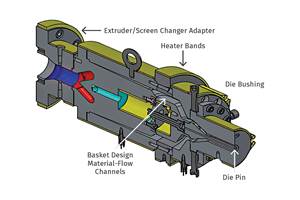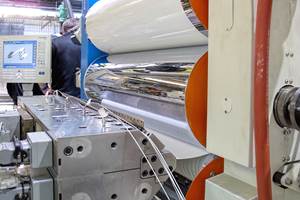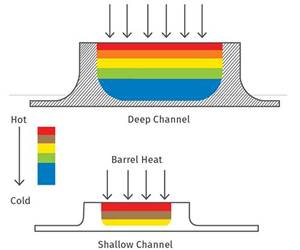A Processor's Guide to Making World-Class Multilumen Tubing
Process innovation is pushing catheter design to the limit. Here are Lubrizol’s tricks of the trade.
When it comes to medical device tubing, the difference between an ordinary extrusion and a truly exceptional one often comes down to a complex, high-stakes process: multilumen extrusion. This highly specialized manufacturing method is responsible for the intricate, multichannel tubing found in many of today’s most advanced medical devices — everything from steerable guide catheters to neurovascular implants.
But why do so many OEMs avoid taking on multilumen extrusion in-house? And what makes certain extruders uniquely equipped to handle the job? The answer lies in a combination of material science, advanced tooling and decades of hard-earned process knowledge — making multilumen extrusion an art form just as much as it is a science.

Why OEMs Avoid It
Even the biggest names in the medical device industry tend to avoid multilumen extrusion in-house because of its extreme complexity. Complexity alone isn’t the problem; it’s the razor-thin tolerances and unforgiving material behavior that make it so hard to master. Many companies have dabbled in multilumen extrusion, only to realize that the level of control required to scale it successfully is beyond what their existing processes can handle.
Multilumen tubing presents a formidable challenge after all. Engineers want increasingly smaller tubing, more lumens and thinner walls — often thinner than a human hair. Holding tolerances that tight, across multiple lumens, while working with materials that can behave unpredictably, is a daunting task to say the least.
Without a firm grasp of material behavior, flow dynamics and die design, achieving consistent multilumen extrusion is nearly impossible.
Flow balancing adds another layer of difficulty. With single-lumen tubing, the material flows smoothly through one continuous channel, but with multiple lumens, every internal pathway must be precisely balanced to prevent distortions, blockages or collapse. Each lumen essentially has its own personality — some take in more material, some resist it and keeping them all in harmony requires meticulous process control. If the material distribution isn’t perfectly controlled, one lumen might collapse, another might expand too much and suddenly you’re looking at an unusable extrusion.
Without a firm grasp of material behavior, flow dynamics and die design, achieving consistent multilumen extrusion is nearly impossible. A single-lumen design allows a polymer to move without much resistance, but in multilumen tubing, each internal channel changes the way material flows and solidifies.
What Materials Work Best?
Polyurethanes and nylons demand precise handling, but their unmatched strength, flexibility and ability to meet medical safety standards make them the best materials for multilumen tubing. Some of the toughest materials to work with in multilumen extrusion are specialized polyurethanes and nylons because they flow unpredictably, degrade under shear and require precise heating to avoid defects.
These materials require an exacting balance of heat, pressure and flow to prevent issues such as premature solidification, die swell inconsistencies or collapse. The complexity of extruding them is then compounded by their narrow processing windows, meaning even minor deviations in temperature, shear rate or residence time can lead to defects like molecular degradation, voids or dimensional instability.
What Are Tooling Considerations?
Of course, mastering multilumen extrusion is not merely a matter of material selection — it is equally contingent on advanced tooling and meticulous process optimization. Appreciate for a moment how industry veterans stress that the most successful extrusion setups rely on proprietary tooling designs developed through years of trial, iteration and empirical refinement, rather than being derived from conventional design principles such as those easily found in textbooks.

Controlling puller speed is critical to maintaining quality in multilumen tubing extrusion. Source: ?????
These specialized tool designs ultimately regulate the polymer flow path at a microscopic level to mitigate shear-induced degradation, reduce polymer crystallization at die exits and ensure dimensional precision down to the micron scale.
Consistency in multilumen extrusion demands that every component of the process — from extrusion die geometry to vacuum calibration — plays a role in keeping lumens stable. Getting a smooth, even melt without excessive heat or strain comes down to the extruder screw design. Processors typically use barrier screws, variable pitch configurations and mixing elements to prevent gel formation and keep viscosity under control.
Die geometry is another critical factor — custom-designed multilumen dies incorporate precision-engineered distribution manifolds to ensure even polymer flow, thereby reducing differential cooling rates which could lead to lumen warping.
How Should Tubing Be Cooled?
For even quality and reliable performance, advanced cooling is just as important as other process controls. That’s why processors trust vacuum sizing tanks, precision water baths and air-knife cooling to lock in quality. But this alone isn’t enough — thin-walled structures are extremely sensitive, and if the puller speed doesn’t sync perfectly with the extrusion rate, things can go wrong fast. Pull too slowly and the tubing thickens or deforms. Pull too quickly and you risk stretching the material too thin, leading to weak spots, oval lumens or complete collapse.
Quality Control
When it comes to multilumen tubing, high-resolution laser micrometry helps manufacturers achieve ultraprecise measurements. These systems continuously measure outer diameter and concentricity, typically exceeding 90% accuracy and, in some cases, even reaching 97% thanks to submicron tracking of lumen geometry.

Leading extruders of multilumen tubing use both inline and offline quality control technologies to ensure products meet or exceed specification.
It’s all about catching problems before they start, including gel formation. Gels are a major challenge wherein tiny, transparent imperfections in the polymer matrix form when polymer chains don’t fully melt, when crosslinked residue builds up or when material stagnates in the tooling. A minor imperfection in everyday products may be overlooked, but in medical devices it can cause materials to fail, functions to falter or pathways to clog.
Thin-walled structures are extremely sensitive, and if the puller speed doesn’t sync perfectly with the extrusion rate, things can go wrong fast.
Processors prevent gels by first filtering the polymer through ultrafine mesh screens, removing any unmelted particles before they can reach the die. However, too much filtering can degrade the polymers or affect mechanical properties.
If you want good melting, mixing and flow, you also need a great extruder screw that does more than just move material. It must be precisely engineered with compression zones, barrier flight elements and mixing sections to ensure the polymer is fully homogenized. If the screw design isn’t right, material inconsistencies can clog the system, produce hot spots which degrade the polymer or affect lumen formation and stability in other ways.
Additionally, manufacturers rely on state-of-the-art defect detection systems to ensure every millimeter of tubing meets the highest standards. Inline optical inspection and infrared spectroscopy can catch the slightest imperfections to ensure that only flawless tubing moves forward in production.

About the Author: Oliver Vasquez is a senior process engineer for medical devices at Lubrizol. With more than 14 years of engineering experience, including eight years in the medical device industry, Vasquez specializes in polymer extrusion technologies for catheter-based devices. In his current role, he supports Lubrizol’s Corona, California, facility by developing novel processing technologies for complex extrusions for device OEMs. He graduated with a bachelor’s degree in mechanical engineering, with a focus on manufacturing, from the University of California, Riverside. Contact: 951-547-7400; ovasquez@lubrizol.com; .
Related Content
How to Select the Right Tooling for Pipe Extrusion
In pipe extrusion, selecting or building a complementary set of tooling often poses challenges due to a range of qualitative factors. Here’s some guidance to help you out.
Read MoreSingle vs. Twin-Screw Extruders: Why Mixing is Different
There have been many attempts to provide twin-screw-like mixing in singles, but except at very limited outputs none have been adequate. The odds of future success are long due to the inherent differences in the equipment types.
Read MoreRoll Cooling: Understand the Three Heat-Transfer Processes
Designing cooling rolls is complex, tedious and requires a lot of inputs. Getting it wrong may have a dramatic impact on productivity.
Read MoreThe Importance of Barrel Heat and Melt Temperature
Barrel temperature may impact melting in the case of very small extruders running very slowly. Otherwise, melting is mainly the result of shear heating of the polymer.
Read MoreRead Next
Making the Circular Economy a Reality
Driven by brand owner demands and new worldwide legislation, the entire supply chain is working toward the shift to circularity, with some evidence the circular economy has already begun.
Read MoreSee Recyclers Close the Loop on Trade Show Production Scrap at NPE2024
A collaboration between show organizer PLASTICS, recycler CPR and size reduction experts WEIMA and Conair recovered and recycled all production scrap at NPE2024.
Read More










